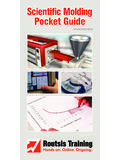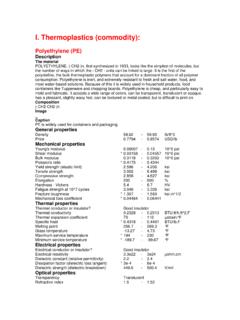Transcription of Scientific Molding Pocket Guide - Routsis Plastics …
1 Scientific Molding Pocket GuideScientific Molding Pocket GuideFOURTH EDITIONS cientfic Molding Pocket Guide Understanding Plastics Plastic Materials Overview Properties, Additives & Preparation Establishing a Scientific Molding Process Seven Steps to Scientific Troubleshooting Molded Part Defects Purging Materials and Techniques Basic Mold & Part design Guidelines Units and Conversions Frequently Used Calculations The Importance of TrainingScientific Molding Pocket Guide275 Donohue Road, Suite 1 Dracut, MA 01826 USAphone: (978) 957-0700email: A. Routsis Associates Inc., All Rights ReservedInjection Molding Reference GuideMaterials, design , Process Optimization, Troubleshooting and Other Practical Information from the Experts at Routsis TrainingPlastics is a sophisticated and diverse discipline. To excel, you need a good grasp of a wide range of concepts and s what this injection Molding Reference Guide is all about. Designed as both a starting point for entry-level personnel and a refresher reference for experienced professionals, this Guide is packed with practical information built on Routsis s 30-plus years of Plastics training and consulting success.
2 The science of Plastics processing Materials and properties Part and mold design basics Process optimization Scientific troubleshootingWhile we hope you find this information useful, it should not be considered a substitute for continuous training. Techniques and technologies are advancing rapidly throughout the industry, which is why top-performing professionals turn to Routsis to keep enhancing their invite you to further explore the topics covered in this Guide through the comprehensive array of online training programs we provide at Box 894 Dracut, MA 01826phone: (978) 957-0700 FAX: (978) 957-1860email: reference Guide contains general recommendations intended solely for informational use within the Plastics injection Molding industry. It is not intended to serve as engineering information contained herein is based on published information, knowledge, research, and experience which are presumed to be accurate and complete to the best of our ability.
3 All information is based on averaged data of commonly available grades of Plastics and current industry practices at the time of this printing. Therefore it is the user s responsibility to review and confirm all design , calculations and processing decisions. You should always design and process using the recommendations that are provided by your raw material supplier, resin distributer, machine and equipment supplier(s). Each material, machine, and process has its own set of influencing factors and therefore may, or may not; comply with the information provided in this Guide . A. Routsis Associates, Inc., will not accept responsibility or liability for use of the information contained within this of ContentsContents1 Understanding General Classification of Polymers Thermoplastics vs. Thermosets Amorphous vs. Semi-Crystalline Hygroscopic vs. Non-Hygroscopic Understanding Variability in Plastics Processing Understanding Viscosity Capillary Rheometry Melt Flow Index Spiral Flow Test In-Mold Rheology 52 Plastic Materials Table of Plastic Material Properties General Information About Common Materials ABS (Acrylonitrile Butadiene Styrene) Acetal or POM (Polyoxymethylene) Acrylic or PMMA (Polymethyl Methacrylate) CPVC (Chlorinated Polyvinylchloride) HDPE (High Density Polyethylene) HIPS (High Impact Polystyrene) Ionomer LDPE (Low Density Polyethylene) LLDPE (Linear Low Density Polyethylene) PA-11 (Nylon-11) PA-12 (Nylon-12) PA-4/6 (Nylon-4/6) PA-6 (Nylon-6) PA-6/10 (Nylon-6/10) PA-6/12 (Nylon-6/12) PA-6/6 (Nylon-6/6) PAEK (Polyaryletherketone) PBT (Polybutylene Terephthalate) PC (Polycarbonate) PC/ABS (PC/ABS Alloy) PC/PET (PC/PET Alloy) PEEK (Polyetheretherketone) PEI (Polyetherimide) PES (Polyethersulfone)
4 PET (Polyethylene Terepthalate) PETG (Polyethylene Terepthalate Glycol) PP (Polypropylene) PPO (Polyphenylene Oxide) PS (Polystyrene) PVC (Polyvinylchloride) SAN (Styrene Acrylonitrile) TPC-ET (Thermoplastic Copolyester Elastomers) TPE (Thermoplastic Elastomer) TPO (Thermoplastic Polyolefin) PPS (Polyphenylene Sulfide) PSU (Polysulfone) PUR (Polyurethane) 203 Properties, Additives & Common Fillers and Fibers Heat Resistance Hardness Burn Characteristics Feed Zone Temperature Study 264 Establishing a Scientific Molding 1st Stage Filling 1st Stage to 2nd Stage Transfer 2nd Stage Pack Screw Delay or Decompression before Recovery Screw Recovery Screw Decompression after Recovery Cooling 28iiiTable of Contents5 Seven Steps to Scientific STEP 1: Develop a Scientific Molding Process 1st Stage injection 1st to 2nd Stage Transfer 2nd Stage Packing Pressure 2nd Stage Time Screw Delay or Decompression before Recovery Screw Recovery Screw Decompression after Recovery STEP 2: Properly Document the Process Outputs STEP 3: Examine Defective Part and Rule-Out Obvious Causes STEP 4: Compare Current Process with Documented Process STEP 5: Return the Process to the Documented Standard STEP 6: Verify the Part and Process STEP 7.
5 Document All Changes Made 326 Visual Defects Flash Sinks and Voids Short Shots Jetting Gate Blush Burning Flow Lines Weld and Meld Lines Poor Surface Finish Dimensional Defects Large Dimensions Overall Small Dimensions Overall Larger Parts at the Gate Smaller Parts at the Gate Warpage Material Defects Splay, Bubbles, and Blisters Brittleness, Cracking, and Crazing Delamination Contamination Poor Color Distribution Cycling Problems Part Sticking and Ejector Pin Marks Occasional Part Hang-Up Nozzle Freeze-Off Drool and Stringing Molded Part Defects Troubleshooting Chart 467 Purging Materials and Purpose of Purging Purging Materials Resin-Based Purging Compounds Mechanical Purging Compounds Chemical Purging Compounds The Four Phases of Purging Purging Techniques Large Shot Purging Small Shot Purging Continuous Purging Closed Mold Purging Dry Purging Wet Purging 518 Basic Mold & Part design Uniform Wall Thickness Corner Radii Ribs and Gussets Draft Angle Undercuts Surface Finish Tool Steels Basic Heat Treatment Common Surface Treatments Common Surface Coatings Wear Considerations Porous Metals 61vTable of Contents9 Units and Time Rotation Temperature
6 Length Speed Area Volume Volumetric Flow Rate Mass Mass Flow Rate Pressure Tonnage Common Conversion Tables 6810 Frequently Used Intensification Ratio Machine Pressure Graph Method Machine Specifications Method Hydraulic Cylinder Method Drying Calculations Material Consumption Dryer Residence Time Dryer Capacity Part Shrinkage Tolerances Chiller Requirements Cooling Time Total Amount of Heat to be Removed Required Cooling Power Cooling Power Per Line Required Volumetric Flow Rate Determining Screw and Barrel Wear Barrel Residence Time 77vi11 The Importance of Training and the Plastics Industry Success Factors for Employee Training Available Training Options Printed Materials Video Training Seminars Online Training On-the-Job Training Structured In-House Training Training Room Setup Program Implementation 8311 Understanding Plastics 1 Understanding General Classification of PolymersIn the industry, Plastics are often referred to as polymers, and the actual plastic pellets are commonly referred to as resin or raw mate-rial.
7 A polymer is classified using different criteria and is considered to be either; natural or synthetic, thermoset or thermoplastic, and amorphous or semi-crystalline. Natural polymers are those found in nature, such as rubber, cotton, and silk. injection Molding calls for the use of man-made synthetic polymers such as polyethylene, ABS, and Thermoplastics vs. ThermosetsPolymers get their strength from a process called polymerization. During polymerization, small molecules called monomers combine to form long polymer chains. Thermosets are polymerized during processing while thermoplastics are polymerized before being processed. During processing, the polymer chains in thermosets fuse together, or cross-link. Once these polymers cross-link, they undergo a chemical change which prevents them from being melted and reprocessed. An egg is an example of a natural polymer which thermosets. Once the egg is heated, it solidifies and cannot be melted are long polymer chains that are fully polymerized when shipped by the resin manufacturer.
8 Thermoplastics can be re-ground, melted and re-processed while retaining most of their original properties. An example of a natural thermoplastic material is wax. It can be melted and formed. Once cooled, the hardened wax can be melted and formed again. Unlike thermosets, most Plastics companies prefer thermoplastic materials because they can be reprocessed and Amorphous vs. Semi-CrystallineThermoplastic polymers can be categorized into two types; amor-phous and semi-crystalline. Amorphous polymers melt gradually when heated. During cooling, amorphous polymer chains solidify slowly in a random orientation. By the end of the cooling phase, they shrink about one half of a percent. Common amorphous polymers include ABS, polystyrene, polycarbonate, and polymers melt quickly, once heated to their melt-ing temperature. The rapidly melting polymer is easy to process compared to amorphous polymers. As a semi-crystalline material cools, portions of the polymer chains remain in a random state 21while portions orient into compact structures called crystalline sites.
9 These crystalline sites increase the strength and rigidity of the poly-mer. During cooling, semi-crystalline polymers shrink up to three percent much more than amorphous polymers. Semi-crystalline polymers include nylon, polyester, polyethylene, and Hygroscopic vs. Non-HygroscopicThermoplastic polymers processed in the Plastics industry are either hygroscopic; meaning they absorb moisture from the air, or non-hygroscopic; meaning they do not tend to absorb moisture from the air. Many low-cost commodity polymers, such as polypropylene, polyethylene, and polystyrene are non-hygroscopic polymers, which do not absorb moisture from the air. Any non-hygroscopic polymer can still get wet when exposed to water, or attract surface moisture in high humidity environments such as outdoor silos, storage tanks, and overseas shipping engineering and specialty resins such as nylon, acetal, and polycarbonate are hygroscopic polymers, which absorb moisture from the air.
10 These polymers have a natural attraction between the resin and water molecules. This creates a chemical bond, causing the polymer to retain water when it is exposed to moisture. In most cases, hygroscopic polymers require air which is both heated and dried to ensure proper material drying. This air must have the mois-ture removed through a dehumidifying process, such as desiccant or vacuum much moisture in a hygroscopic polymer will interfere with the Molding process due to hydrolysis. Hydrolysis is the breakdown of a water molecule when heated. Once broken down into hydrogen and oxygen, these molecules will chemically react with the polymer chains, causing them to break. Visual defects such as splay, poor surface finish, bubbles, or delamination can occur as a result of moisture in hygroscopic polymers. Hydrolysis can also cause a sig-nificant change in the physical proper ties of the polymer including: reduced strength, increased brittleness, dimensional stability, poor heat resistance, and tendency to Understanding Variability in Plastics ProcessingThe development of a robust injection Molding process is highly dependent on the injection molder s ability to cope with variability.





